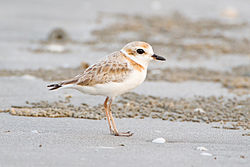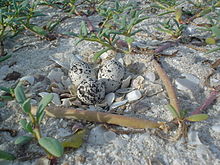- Malaysian Plover
-
Malaysian Plover 
female Conservation status Scientific classification Kingdom: Animalia Phylum: Chordata Class: Aves Order: Charadriiformes Family: Charadriidae Genus: Charadrius Species: C. peronii Binomial name Charadrius peronii
Schlegel, 1865The Malaysian Plover (Charadrius peronii) is a small (ca. 35–42 g) wader that nests on beaches and salt flats in Southeast Asia.
Contents
Description
The Malaysian Plover is 15 cm (5.9 in) in length. The male can be recognized by a thin black band around the neck; the female has a thin brown band. Its legs are pale. Its voice is a soft twit.[2]
Reproduction
The Malaysian plovers lays two to five (mode of three) cryptic eggs on small scrapes on beaches. The eggs are incubated by both the male and female for about 30 days, and then both parents care for the precocial chicks until they can fly after about 30 more days . In Thailand, it may lay multiple clutches after successful or failed clutching during the breeding season which begins in late March and may last until September. It feeds on invertebrates on the beaches and mudflats.[3]
Conservation status
This species is classified as near-threatened[1] with about 10,000 individuals. They are thought to be declining because of infrastructure development and human disturbance. Increased human use of important beach habitat may cause trampling of eggs or chicks and also force adults off of nests so that eggs and chicks are vulnerable to heat stress. A study in the Gulf of Thailand suggested that the conversion of short, shrubby, dense vegetation into sparse Casuarina forests as well as the creation of sea walls that prevent chicks from moving between foraging areas on the mudflat and hiding habitats in the vegetation behind the beaches, could reduce habitat quality for Malaysian plovers.
Sandy tropical beaches have tremendous economic value and as a result there has been intensive development pressure on the remaining Malaysian plover habitats in Thailand. This is likely to continue as the Thai economy continues to improve from the Asian financial crisis and the domestic tourist market expands. The main remaining large populations of Malaysian plovers in Thailand are in Khao Sam Roi Yot National Park (Thailand's first marine protected area), and beaches around Bonok village both in Prachuap Khiri Khan province and Laem Phak Bia in Petchburi province. Bonok made headlines in the Thai and international media when a prominent environmental activist (Charoen Wataksorn) who helped to protect one of these undeveloped beaches from the construction of a coal power plant, was murdered after protesting against illegal land grabs on one of these beaches [4]. The construction of a seawall in 2005 in Laem Phak Bia (a sandy, 1 km (.62 mi) long spit in Petchburi province) is likely to have significantly altered the habitat.
Footnotes
- ^ a b BirdLife International (2004). Charadrius peronii. 2006. IUCN Red List of Threatened Species. IUCN 2006. www.iucnredlist.org. Retrieved on 11 February 2008. Database entry includes justification for why this species is near threatened
- ^ Strange, Morten (2003). A Photographic Guide to the Birds of Indonesia. Princeton, NJ: Princeton University Press. pp. 99. ISBN 0691114951. http://books.google.com/books?id=i6pl-5ReqSIC&pg=PA99&dq=Charadrius+peronii+%2B&as_brr=3&ie=ISO-8859-1&sig=K531qdLEVktuRnuxdWPr_hpeJow.
- ^ Marine Protected Areas Research Group
- ^ Greenpeace Southeast Asia
References
- Parr, J. W. K., Mahannop, N., Charoensiri, V., 1993. Khao Sam Roi Yot - one of the world's most threatened parks. Oryx 27, 245-249.
- Yasué, M. Dearden, P. 2006. The effects of heat stress, predation risk and parental investment on Malaysian plover nest return times after a human disturbance. Biological Conservation. 132, 472-480.
- Yasué, M. Dearden, P. 2006. The potential impacts of tourism development on the habitat availability and productivity of the Malaysian plovers (Charadrius peronii). Journal of Applied Ecology, 43: 978 – 989
- Yasué, M. Dearden, P. 2006. Simultaneous biparental incubation of two nests by a pair of Malaysian plovers. Wader Study Group Bulletin. 109: 121 – 122.
- Yasué, M. Dearden, P. 2007. Are salt flats suitable alternative breeding habitats for Malaysian plovers Charadrius peronii threatened by beach habitat loss in Thailand. Bird Conservation International, In press.
- Yasué, M. Dearden, P. 2007. The parental sex roles of Malaysian plovers during territory acquisition, incubation and chick-rearing, Journal of Ethology, In press.
Categories:- IUCN Red List near threatened species
- Charadrius
Wikimedia Foundation. 2010.



